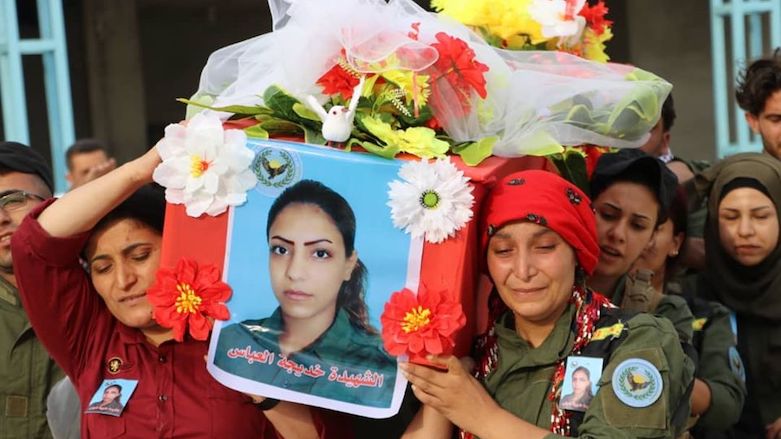Turkish-backed groups, ISIS cells target women working with SDF

ERBIL (Kurdistan 24) – Khadija Abbas al-Abbas, a member of the Internal Security Forces of North and East Syria, also known as Asayish, was buried on Wednesday in the town of Abu Khashab in Deir al-Zor after she was killed in an ambush by the so-called Islamic State.
The Syriac Press agency reported that she was killed on Monday “after gunmen on motorcycles, suspected to be members of the Islamic State, opened fire on an Asayish vehicle on the road to Abu Khashab in western Deir al-Zor.”
The Islamic State later claimed responsibility for the attack via its semi-official Amaq news agency.
According to independent researcher Caki, this is the first instance where the Islamic State has confirmed the killing of a female Asayish member.
Caki added that the Islamic State had also killed female Asayish members in Manbij at the beginning of the year. The terror group also targeted women houses that were set up in Raqqa and Deir al-Zor to promote female rights.
Lina Abdulwahid, a female member from the Future party, survived an assassination attempt by the Islamic State last November in the Suwar area of Deir al-Zor.
“Women in the region hold an important role for the future,” Caki stated. “Not only is this seen as a threat [by] ISIS who have threatened women who work with the [autonomous] administration but also that of Turkey and their mercenaries.”
The Turkish-backed Ahrar al-Sharqiya group summarily executed female politician Hevrin Khalaf in mid-October 2019 as part of Ankara’s cross-border offensive. A Turkish drone also killed three Kurdish women activists on June 23 in Kobani.
The Syrian Democratic Forces (SDF), Women’s Protection Units (YPJ), and the Asayish have recruited many Arab women in the more conservative areas of northeastern Syria after regions such as Manbij, Raqqa, and Deir al-Zor were liberated from the Islamic State.
Amy Austin Holmes, a Fellow at the Woodrow Wilson Center and Visiting Scholar at Harvard University, told Kurdistan 24 that she interviewed Arab women in Syria “about their experiences and why they joined the YPJ/SDF”—many of whom did so to escape the Islamic State’s oppressive rule.
“Many people have a hard time understanding what it was like to live under ISIS [rule],” Holmes added.
“Not just the horrific brutality—but also the pure suffocation many women especially felt at being prisoners in their own homes. So when the YPJ/SDF liberated their cities, they signed up.”
However, the SDF’s egalitarian system could also result in resentment among Arab tribes. A Pentagon Inspector General (IG) report covering the second quarter of 2019 (April. 1 to June 30, 2019) suggested that “ISIS could exploit other cultural differences, such as the differing gender roles between the ‘egalitarian SDF’ and ‘traditional Arab society’ to gain support.”
It could also be for this purpose that the Islamic State and Turkish-backed groups have targeted females who support the Autonomous Administration of North and East Syria (AANES) and SDF-linked institutions.
As such, the AANES has been more careful in implementing gender equality laws in Arab majority areas.
Instead, local women’s councils have been set up in Arab majority areas to educate the local populations and lay the groundwork for more gender equality. However, sleeper cell attacks by both the Islamic State and Turkish-backed groups pose an ongoing risk.
Editing by Karzan Sulaivany
